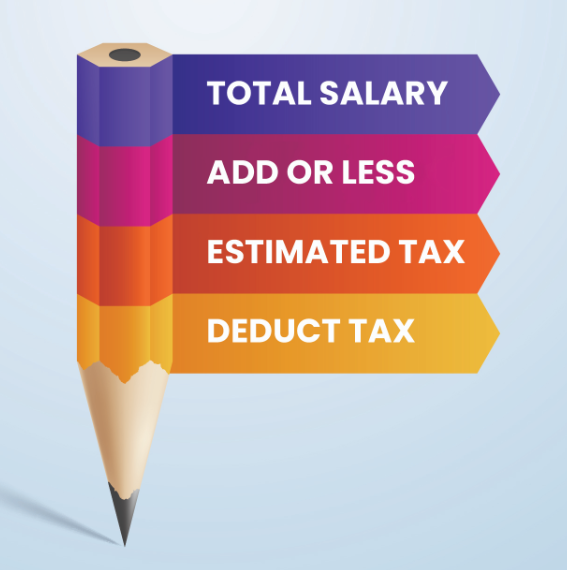Easy Tax Deductions Guidance
Employee TDS: Simplifying Tax Deductions for Employers
A major component of financial management for both individuals and corporations is paying taxes. The Income Tax Department of India introduced the Tax Deducted at Source (TDS) system, which requires the person in charge of making certain payments—like rent, interest, commission, professional fees, salary, etc.—to withhold a predetermined amount of tax before paying the recipient in full. This idea is especially important when it comes to paying employees' compensation. Employees are the deductees while employers are the deductors. The goal of this blog is to make Employee TDS concepts easier to understand so that employers are prepared to properly handle these deductions.
What is the TDS for Employees?
TDS for employees is a crucial component of an employer's payroll procedure. It is the amount of tax that companies must automatically withhold each month from the wages of their workers. This method of collecting taxes straight from an individual's wages is mandated by the Indian Income Tax Department in order to guarantee a consistent income stream for the government.
Importance of Employee TDS
The main goal of implementing Employee TDS is to reduce tax evasion by obtaining tax information directly from the source of income. With this strategy, the government receives a portion of the income before the individual does.
- Tax Law Compliance: By withholding taxes at the source, this ensures employers follow the guidelines outlined in the Income Tax Act, avoiding penalties.
- Steady Government Revenue: Enables the government to receive tax money regularly, supporting welfare and national development initiatives.
- Minimized Tax Evasion: Assures a fair tax collection system by reducing instances of tax evasion by deducting taxes directly from salaries.
- Spreading the tax payment over the course of the year makes it easier for employees to manage their finances because they are not faced with a one-time lump sum tax payment.
- Streamlined Tax Administration: Increases efficiency by streamlining the tax administration procedure for the government and the employer.
- Employees who receive an immediate tax credit can use it to help with their investment and financial planning.
- Documentation and Transparency: Ensures that Form 16 is properly completed, which promotes transparency and makes it easier for employees to file their yearly income tax returns.
- Financial Discipline: Encourages employees to practice financial discipline by teaching them the value of saving and planning their taxes.
TDS on Employee Salary: An Overview
In India, to guarantee tax compliance and organized tax collection, TDS on employee salary is an essential part of the payroll process. The idea is to take a specific percentage of taxes out of an employee's pay before they are paid, which goes straight into the national treasury.
Employers and employees equally must understand TDS regarding employee salary. Employers are in charge of calculating and deducting the correct amount of TDS based on the applicable income tax slabs and the taxable income of their employees. This involves having a detailed understanding of the TDS on employee salary, which takes into account exemptions, standard deductions, and other relevant factors that affect taxable income.
One cannot stress how crucial it is to handle TDS on employee salaries correctly.
Employers benefit from ensuring adherence to the Income Tax Act and avoiding possible legal problems. Because the deducted TDS appears in their Form 16, which summarises their income and tax deductions for the year, it makes financial planning and tax filing easier for employees.
Effective tax management requires regular updates and an understanding of the current Employee TDS salary limits and regulations. Accurate TDS computation can be facilitated by using tools such as an Employee TDS calculator, which will guarantee compliance and peace of mind for all concerned.
Employee TDS Limit
The lowest income level below which TDS will be subtracted from an employee's pay is known as the Employee TDS limit. This cap is subject to adjustments that are disclosed annually during the Union Budget. According to current regulations, TDS is imposed if an employee's yearly salary surpasses the basic exemption threshold. Employers need to stay informed about these caps in order to guarantee correct deductions and adherence to tax regulations.
Calculating Employee TDS

Understanding the current income tax slabs and exemptions offered by the Income Tax Act is necessary to calculate TDS on an employee's salary. An Employee TDS Calculator is a tool that employers can use to simplify and eliminate errors in these calculations. Employers can calculate the precise amount of TDS to be deducted each month by entering information about the employee, including age, gross salary, exemptions, and deductions under various sections of the Income Tax Act.
How to Determine Employee TDS
- Calculate Your Taxable Salary: Determine the employee's gross annual salary and subtract any applicable exemptions from it under different sections (80C, 80D, etc.).
- Utilise the Appropriate Income Tax Slabs: Determine the income tax on the annual taxable salary using the most recent tax slabs.
- Integrate Cess Education: Include the education and health cess in the computed income tax.
- Monthly Deduction: The monthly TDS amount is calculated by dividing the total annual tax liability by 12.
This procedure is made simpler by using an employee TDS calculator, which also guarantees accuracy and adherence to current tax regulations.
Observance and Documentation
The Income Tax Act imposes a number of requirements on employers about Employee TDS. This involves obtaining a Tax Deduction Account Number (TAN), correctly deducting TDS by the Employee TDS cap, and providing Form 16 to workers on a yearly basis. Employers are also required to keep thorough records for audit purposes and submit their TDS returns on time each quarter. Following these procedures guarantees adherence to the law, reduces financial risk, and upholds openness and employee trust.
- TAN Enrollment: A TAN, a distinct 10-digit alphanumeric number used to track TDS deductions and payments, is required for every employer. Employers are unable to file returns or deduct TDS without a TAN.
- Form 16 is issued: An employee must receive a certificate on Form 16 from their employer. It includes information about the salary paid and TDS withheld throughout the year. Employees must have this document in order to file their income tax returns, so it is essential.
- Employers must submit quarterly TDS returns that include a breakdown of all TDS deductions made during the quarter. To avoid penalties, these returns must be accurate and submitted by the deadlines specified.
Problems and Solutions
Employers may encounter several difficulties when handling employee TDS, including keeping up with tax slab updates, precisely calculating TDS, and guaranteeing timely compliance. To solve these difficulties:
- Updating knowledge frequently: Employers need to stay current on the newest tax regulations and slabs.
- Employers can use technology to expedite calculations and compliance by utilizing software solutions like payroll software and employee TDS calculators.
- Getting expert advice: Tax professionals can assist in understanding complex situations and guaranteeing compliance.
- Training and development: The HR and accounting teams can manage Employee TDS more effectively by holding regular training sessions.
The Best Ways to Handle Employee TDS
The following best practices can be implemented by employers to guarantee efficient management of Employee TDS:
- Ensure that your records are accurate: Maintain thorough documentation of all employee declarations, exemptions, and deductions.
- Talk to the staff: Remind staff members on a regular basis about their tax obligations, TDS deductions, and any changes to the law.
- Assure prompt adherence: Respect all deadlines for filing returns, making deposits, and deducting TDS.
- Use technology: To automate and speed up TDS calculation and compliance, use advanced payroll and TDS software.
- Regular audits: Ensure accuracy and adherence to tax laws by conducting routine audits.
To sum up
In India, managing employee TDS is a crucial part of an employer's duties. Employers can streamline this intricate process by learning the fundamentals of TDS, using resources like the Employee TDS Calculator, and complying with regulatory obligations. To further reduce the workload and guarantee a seamless and effective payroll process, regular updates, the use of technology, and expert advice can all be helpful. Recall that accurate and timely TDS management encourages employee trust and transparency in addition to aiding with compliance.
Frequently Asked Questions
Q.1. What is Employee TDS?
Employee TDS (Tax Deducted at Source) refers to the tax that employers are required to deduct from their employees' salaries each month. It is a mechanism put in place by the Indian Income Tax Department to collect taxes directly from an individual’s earnings.
Q.2. What is the Employee TDS limit?
The Employee TDS limit is the minimum income threshold beyond which tax is required to be deducted from an employee's salary. This limit can vary each financial year based on tax laws and budget announcements. Typically, TDS is applicable if an employee's annual income exceeds the basic exemption limit set by the Income Tax Department.
Q.3. How do I figure out TDS based on an employee's pay?
An employee TDS calculator can be used to determine TDS on an employee's salary. The employee's yearly income, any applicable deductions, and any tax exemptions must be entered into this tool. The monthly TDS to be withheld from the employee's pay is then calculated by applying the current income tax slabs.
Q.4. What is the nature of TDS on employee salary?
TDS on employee salary refers to the subtraction of a predetermined percentage of tax from the gross monthly salary of the employee. The precise percentage is determined by taking into account all allowable deductions and exemptions, then applying the applicable income tax slab rates. On behalf of the employee, the government receives the TDS that has been subtracted.
Q.5. How is Employee TDS on salary different from other forms of TDS?
Employee TDS on salary specifically relates to the tax deducted at source from an individual’s salary by the employer. This is distinct from other forms of TDS, which might be applied to payments such as interest from banks, professional fees, or rent. The key difference lies in the income; employee TDS is exclusively for salary income, while other TDS forms apply to different types of income.

